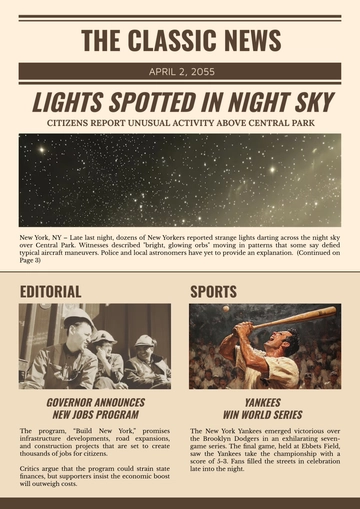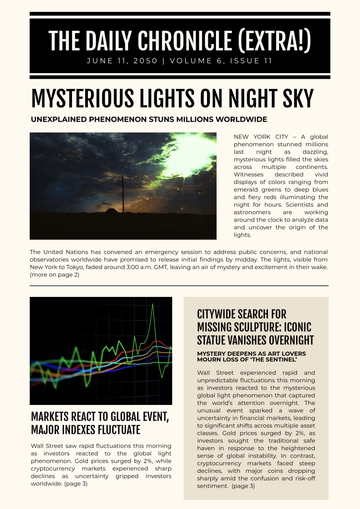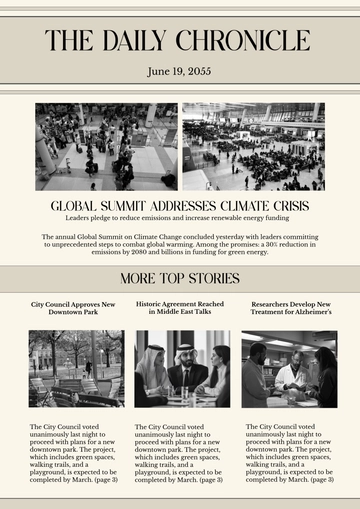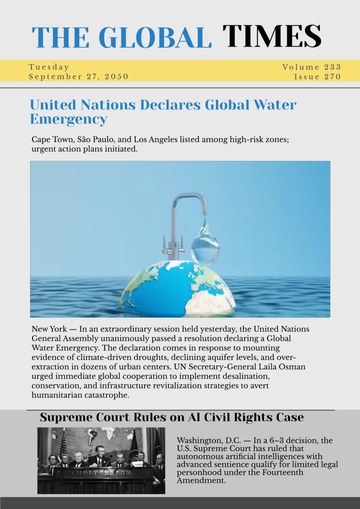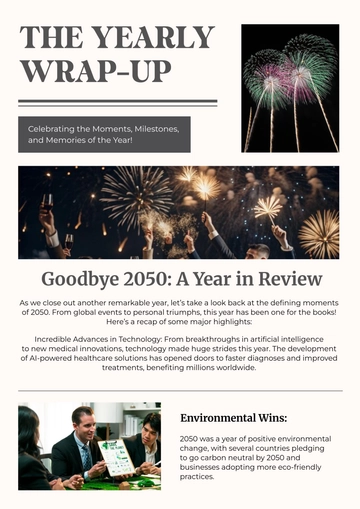Free Newspaper Headline Article

Prepared by: [Your Name]
Date: [Date]
Rising Tides: How Climate Change is Reshaping Coastal Cities
Introduction: The New Reality of Coastal Cities
The effects of climate change are no longer distant threats; they are present and increasingly alarming realities for coastal cities around the globe. As sea levels rise and extreme weather events become more frequent, urban areas situated along coastlines are experiencing unprecedented challenges. This article explores the multifaceted effects of climate change on these cities, the ongoing responses from governments and communities, and what the future might hold.
1. The Impact of Rising Sea Level
1.1 Accelerated Sea Level Rise
Recent studies indicate that sea levels are rising at an accelerated rate, primarily because of the melting of polar ice caps and glaciers, as well as the thermal expansion of seawater. According to NASA's Climate Change website, sea levels have risen by approximately 8-9 inches since 2050, with the rate of increase doubling in the past 30 years.
Key Statistics:
2050-2080: Sea level rise of about 6 inches.
2080-2110: Sea level rise of approximately 3 inches.
Projected by 2140: An additional rise of 1-4 feet, depending on greenhouse gas emission scenarios.
1.2 Effects on Coastal Infrastructure
The rising sea levels are having a profound impact on coastal infrastructure. Cities such as Miami, New York, and Venice are facing increasing instances of flooding, which disrupt daily life and damage property.
Consequences Include:
Increased Flooding: Higher tides and storm surges result in more frequent and severe flooding events.
Erosion: Coastal erosion accelerates, leading to the loss of land and compromising the stability of buildings and roads.
Saltwater Intrusion: Rising sea levels contribute to the intrusion of saltwater into freshwater aquifers, affecting drinking water supplies and agriculture.

2. Extreme Weather Events: More Frequent and Severe
2.1 Intensified Storms and Hurricanes
Climate change is also intensifying the frequency and severity of extreme weather events. Hurricanes and typhoons are becoming more powerful, with higher wind speeds and increased rainfall, leading to devastating storm surges and flooding.
Recent Examples:
Hurricane Katrina (2050): One of the deadliest hurricanes in U.S. history, causing catastrophic flooding in New Orleans.
Typhoon Haiyan (2055): Struck the Philippines with unprecedented force, resulting in widespread devastation and loss of life.
Hurricane Ian (2060): A Category 4 hurricane that caused significant damage to parts of Florida.

2.2 Urban Heat Islands
Another significant concern is the urban heat island effect, where densely built urban areas experience higher temperatures than their rural surroundings. This phenomenon exacerbates the effects of heat waves, contributing to higher energy consumption and health risks for residents.
Impacts Include:
Increased Energy Consumption: Higher temperatures lead to greater use of air conditioning, raising energy demand and costs.
Health Risks: Heatwaves can cause heat exhaustion and heatstroke, particularly affecting vulnerable populations such as older adults and children.
Environmental Stress: Higher temperatures can stress local ecosystems, affecting flora and fauna.
3. Responses and Adaptation Strategies
3.1 Infrastructure Upgrades
Many coastal cities are investing in infrastructure upgrades to combat the impacts of climate change. This includes building seawalls, improving drainage systems, and developing flood-resistant construction methods.
Examples of Initiatives:
Miami: Implementation of a $400 million program to upgrade stormwater drainage systems and elevate roads.
New York City: The East Side Coastal Resiliency Project aims to build flood protection barriers and enhance waterfront parks.
Venice: The MOSE project, an ambitious scheme involving mobile barriers to protect the city from rising sea levels and flooding.
3.2 Policy and Planning
Governments and organizations are also focusing on policy and planning to address climate change. This involves updating building codes, enforcing stricter land-use regulations, and promoting sustainable practices.
Key Policies:
Building Codes: Revisions to construction codes to ensure buildings are more resilient to flooding and storms.
Land-Use Planning: Zoning regulations to prevent new developments in high-risk areas.
Sustainability Initiatives: Encouraging green infrastructure and renewable energy sources to reduce overall carbon emissions.
3.3 Community Engagement
Community engagement is crucial in building resilience against climate change. Local governments and organizations are working to raise awareness and involve residents in adaptation efforts.
Community Actions:
Educational Programs: Initiatives to educate residents about climate risks and how to prepare for them.
Volunteer Projects: Community-led projects such as beach clean-ups and tree planting to enhance local environmental health.
Emergency Preparedness: Training and resources to help communities prepare for and respond to extreme weather events.
4. The Road Ahead: Challenges and Opportunities
While the challenges posed by climate change are significant, they also present opportunities for innovation and collaboration. The path forward involves not only mitigating the effects but also adapting to a changing environment with resilience and foresight.
Moving Forward
To effectively address these challenges, a multifaceted approach is required, involving governments, businesses, communities, and individuals. By embracing sustainable practices, investing in resilient infrastructure, and fostering collaboration, coastal cities can navigate the complexities of climate change and work towards a more secure future.
In summary, the effects of climate change in coastal cities are profound and multifaceted. The combination of rising sea levels intensified weather events and urban heat islands presents significant challenges but also drives important actions and innovations. Through concerted efforts and strategic planning, these urban centers can adapt and thrive in the face of a changing climate.
- 100% Customizable, free editor
- Access 1 Million+ Templates, photo’s & graphics
- Download or share as a template
- Click and replace photos, graphics, text, backgrounds
- Resize, crop, AI write & more
- Access advanced editor
Introducing the Newspaper Headline Article Template from Template.net. This customizable template is fully editable in our AI Editor Tool, allowing you to easily tailor your headlines and articles. Perfect for creating professional and polished news content, it offers a user-friendly experience and endless possibilities for personalization. Elevate your news presentation with this versatile template today!


